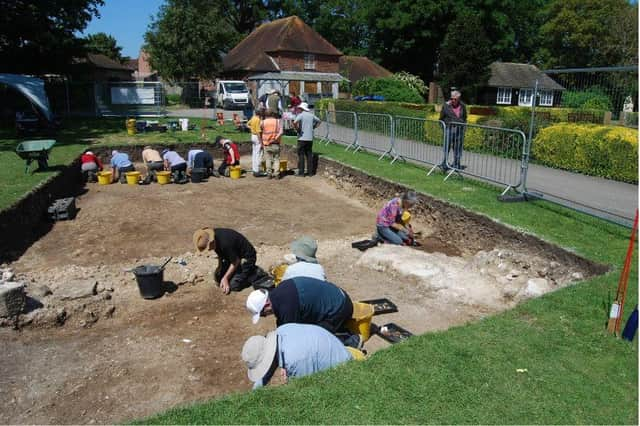Remains of Chichester’s Norman castle uncovered for first time since the Middle Ages


The two-week dig has been led by Chichester District Council’s Archaeologist, James Kenny, in partnership with the Chichester and District Archaeology Society (CDAS). Other discoveries include the foundations of the walls associated with a building that was part of a medieval Franciscan Friary that stood on the site, including a buttress on the south-east corner of the building.
The friary existed between the late-13th to the mid-16th centuries and would have comprised a series of buildings including the Friary church, a dormitory, refectory, library, a cloister with wash house, a guest house and even a brewery! Following the dissolution of the monasteries, in the late 1530s, the Friary church became a council house and the rest of the buildings were converted to a mansion house. This was demolished in the mid-19th century when the area was transformed into Priory Park.
Advertisement
Hide AdAdvertisement
Hide AdThese exciting last-minute discoveries were made at the very end of the dig and will help local historians to build a more complete picture of Chichester’s history.
“We carried out geophysical surveys on the site so we had a good idea of where to find the walls of the friary buildings,” explains James. “What is remarkable is that the wall was placed right hard up against the outside edge of an enormous ditch which is almost certainly the ditch created for the motte,” explains James. “The castle was probably built in 1066 or 1067 directly after the Norman Invasion by Earl Roger Montgomery who was one of the most important Norman barons, in charge of most of what would become West Sussex.
Only a small part of the motte remains today, but back then it would have been a significant structure – four or five times bigger than it is today – and probably comparable in size to the one at Arundel Castle. The material from the ditch was used to build the motte, which was intended to intimidate the Urban English population and to dissuade them from rebelling against the new Norman lords.
“What we have found is the sloping edge of the ditch, and it’s exciting because this is the first time that anyone will have seen it since the Middle Ages. This ditch would have been very wide and very deep, and because of the dig we’ll now be able to determine more accurately just how big it would have been.”
Advertisement
Hide AdAdvertisement
Hide AdIn addition, the archaeology team also found a short and well-built limestone wall which butts up against the end wall of the Franciscan Friary building.
James says: “This wall must pre-date the friary building and lies over the outside edge of the ditch and we think that it is most likely the remains of the bridge that serviced the motte. The wall is made from a range of limestone including locally from Lavant and off Selsey Bill, and then also the Isle of Wight and Caen stone from Normandy itself. It’s a very solid structure indeed and it’s amazing for us to have revealed this element of Chichester’s Norman past.
“What is so exciting about this find is that we’ve never before in our lifetimes seen the masonry associated with the Norman castle before – finding the wall has been an unexpected bonus. Just this little bit of archaeology will allow us to rewrite the history of Chichester and build a better understanding of our past. “You never know how a dig is going to go, and it’s typical, but very pleasing, to have made these discoveries at virtually the last minute! Overall, the dig has been very successful and lots of people have come to watch and find out what we have been doing – it’s been a great community project.”
During the two weeks the dig team also found a variety of other objects such as fragments of glazed tiles which were probably used in the friary plus Roman pottery, tiles and coins.
Advertisement
Hide AdAdvertisement
Hide AdChichester District Council’s Cabinet Member for Planning, Councillor Bill Brisbane said: “These findings are fantastic and really help tell us more about the fascinating history of the city of Chichester. I am pleased that the council has been able to fund this dig and give people an opportunity to see archaeology in action on their own doorstep.
“It’s been an impressive team effort and I would like to give my thanks to the 60-strong team of volunteers who have supported us with the dig this year and I look forward to hearing more about all the findings once they have all been recorded.”